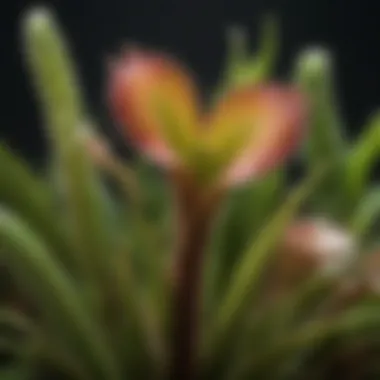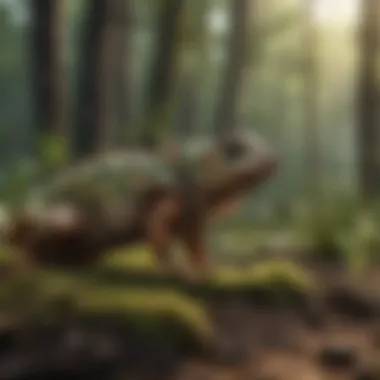Discovering the Intriguing World of Killer Plants


Nature Topic Overview
Nature is.full of remarkable and mysterious things. Among these are killer plants. These plants are not just ordinary green living things; they have incredible ways of surviving in tough environments. They can trap insects, and some even have tastes that can be dangerous for animals that get too close. In this section, we will explore what makes killer plants so fascinating.
Killer plants come in many shapes.and sizes. Some are meat-eaters like the Venus flytrap, while others are poisonous like the foxglove. They have evolved to adapt to their specific environments. Some thrive in wet marshes or dry deserts.
Every killer plant has a unique story and role it plays in its ecosystem. Understanding these plants helps us see the amazing connections in nature. It is essential to learn about these kinds of plants through both their positive and negative impacts.
Fun Facts and Trivia
Learning about killer plants is exciting! Here are a few fun facts:
- Venus flytrap: It can close its leaves in just one-tenth of a second, trapping unsuspecting insects.
- Pitcher plants often attract insects with sweet scents and bright colors.
- Deadly nightshade, also known as belladonna, can cause serious illness just by being touched.
Adding interactive elements can boost your learning experience. Consider these ideas:
- Make a colorful poster about your favorite killer plant.
- Use the paper to win a small prize in a classmate quiz!
Wildlife Explorations
Killer plants are not alone in their environments. Many animals exist around these plants. For example:
- Insects like flies are quick snacks for the Venus flytrap.
- Certain frogs make their homes near pitcher plants, as they provide water and protection.
By understanding various species and their connections, children can appreciate the ecological web that connects all living things. Max, the student naturalist, loves visiting wetlands to see plants and animals interact.
Interactive Features
- Try creating a simple quiz regarding plants you learn about!
Environmental Awareness
Our planet's well-being relies on balanced ecosystems. Killer plants have unique roles, requiring us to protect them.
Respect for nature is crucial. Here are tips for children to help protect our living environment:
- Always dispose of trash to avoid harming any plants.
- Join a tree planting event to promote new life forms!
Remember, every small action can lead to big changes!
Taking part in conservation efforts contributes to global survival.
DIY Nature Activities
Hands-on activities boost what you learn about killer plants. Here are some ideas!


- Plant Discovery Craft: Create a diorama of a specific killer plant in its habitat using colored paper, leaves, and twigs.
- Observation Journals: Carry a small notebook while outside. Write or draw your findings about different plants you see.
- Local Exploration: Visit a natural area with plant species.
These engaging activities can deepen knowledge processes for young learners and nurture their curiosity about nature.
Prelude to Killer Plants
Killer plants hold a unique position in the natural world. They charm and intrigue both young minds and seasoned naturalists alike. This section sets the stage for understanding the multiple dimensions these plants present. They challenge our perceptions of flora in unexpected ways and reveal a surprising complexity in how plants evolve and adapt.
Understanding the Term 'Killer Plant'
The term 'killer plant' generally refers to three categories: carnivorous plants, poisonous plants, and parasitic plants. Each of these groups has distinct mechanisms and strategies for survival. Carnivorous plants, such as the Venus Flytrap, consume insects for nutrients. Poisonous plants, like the Deadly Nightshade, develop toxic compounds to deter herbivores or humans. Lastly, parasitic plants, including Mistletoe, draw sustenance from their host plants, which can be harmful. This understanding is crucial as it allows us to appreciate these plants more clearly without confusion. At the same time, we learn to navigate their unique traits more safely.
The Allure of Fascinating Flora
Many individuals are drawn to quite unusual plants in nature. This fascination stems from their odd behaviors, colors, and adaptations. Killer plants illustrate nature's diversity and resilience. For example, the Pitcher Plant, with its captivating tubular shape and enticing nectar, demonstrates effective traps for unsuspecting insects. Kids and adults alike marvel at the intricacies of these plants. By studying them, people discover how life has figured out ways to flourish even in tough conditions. This helps nurture a sense of wonder about biology and the interconnectedness of life.
"Nature presents us with endless mysteries, it shown us how life thrives under sometimes harsh conditions."
Moreover, the educational value becomes clear as we explore their roles in ecosystems. Learning about killer plants can create an opportunity for appreciation of the great biodiversity that exists on Earth. Such understanding enriches experiences in outdoor spaces. It shifts Kids’ perspectives towards curiosity instead of fear, encouraging an even deeper connection to the world around them.
Types of Killer Plants
Killer plants hold a significant place in ecosystems and in our curiosity about the natural world. They display unique adaptations that enable them to survive in harsh conditions. Understanding the types of killer plants helps us appreciate biodiversity and the roles different plants play. Children will find the mysteries of these plants both fascinating and educational. Engaging with killer plants sparks an interest in plant biology and ecology.
Carnivorous Plants
Carnivorous plants are perhaps the most well-known types of killer plants. They uniquely trap and digest insects, supplementing their nutrient intake.
Venus Flytrap
The Venus Flytrap is a remarkable plant known for its spectacular trapping mechanism. Its leaves are shaped like jaws that snap shut when triggered by unsuspecting insects. This plant contributes greatly to our understanding of plant behavior and adaptations. The key characteristic of the Venus Flytrap is its rapid movement, which is rare in the plant kingdom. This trapping method provides the plant with essential nutrients that may be limited in its soil.
- Unique Feature: It can close its jaws in less than a second if its sensitive hairs are triggered.
- Advantages: The Venus Flytrap thrives in nutrient-poor environments.
- Disadvantages: It requires a specific care routine to grow well, making it less suitable for inexperienced plant owners.
Sundew
Sundew plants are covered in glandular hairs that produce sticky dew. This adaptation aids in capturing prey. The sticky droplets lure insects to the plant’s surface. Once caught, the hairs wrap around the insect, aiding digestion. The sundew’s fascinating trait is its ability to move slightly to secure its meal. This contributes a lot to our knowledge about plant responsiveness and adaptability.
- Key Characteristic: Its sticky tentacles serve as effective traps for insects.
- Advantages: Sundews are remarkable survivors in poor soils.
- Disadvantages: They are sensitive to water quality and require specific humidity levels.
Pitcher Plant
Pitcher plants are another interesting group of carnivorous plants. Their distinctive tube-shaped leaves hold rainwater, where insects drown. They are often brightly colored to attract prey. A key characteristic of pitcher plants is their deep cavity filled with liquid, which contains enzymes for breaking down insects. This trait showcases the complexity of many plants adapting to their environments to gather nutrients.
- Unique Feature: Their water-filled


The Mechanisms Behind Their 'Killer' Traits
The topic of The Mechanisms Behind Their 'Killer' Traits is crucial as it reveals how might plants have evolved in extraordinary ways to adapt, survive, and thrive in demanding environments. Knowing these mechanisms sheds light not only on the anatomy and physiology of these plants, but also our human interactions with them. This section opens several layers of understanding, such as ways they capture their prey or ensure no once else can use their nutrients. Each plant adopts specific strategies, showcasing their uniqueness and bio-engineering toward survival.
How Carnivorous Plants Trap Their Prey
Carnivorous plants have evolved fascinating ways to capture their pet prey. These adaptations allow them to obtain nutrients in environments where the soil lacks richness. Most commonly found species include the Venus Flytrap, Sundew, and Pitcher Plant.
- Venus Flytrap: This luxurious green creature catches insects with its hinged leaves. When an unsuspecting bug touches the trigger hairs inside the leaf, their traps snap shut swiftly, securing the prey inside.
- Sundew: This plant attracts insects with nectar. Once an insect is distracted and lands on its sticky glandular hairs, it provides a perfect meal as the leaf curls around to digest.
- Pitcher Plant: Sporting beautiful tubular structures, these bags lure creatures with alluring odors. After falling inside, slippery walls detain the critter, keeping it submerged for digestion.
Each method underscores the diversity in the ways these plants can enhance nutrient intake successfully.
The Chemical Warfare of Poisonous Species
Poisonous plants utilize chemical warfare through thrilling biochemical interactions. Each species produces specific toxins that deter herbivores or predators, ensuring their survival.
Plants such as Deadly Nightshade, Foxglove, and Castor Bean are prime examples exhibiting varied mechanisms:
- Deadly Nightshade: Contains tropane alkaloids, making its berries beautiful yet dangerous. Eating even a few and can lead to severe symptoms and, st times, death.
- Foxglove: Graceful in appearance, contains cardiac glycosides toxic to mammals. They hinder heart functions when taken internally.
- Castor Bean: Despite having edible oil, the seeds carry ricin, an incredibly potent toxin through any means of consumption.
These toxins play an ecological role as self-defense mechanisms, simultanously educating us on the balance of nature's ecosystem.
Strategies of Parasitic Plants
Parasitic plants take a different approach towards thriving: they extract nutrients and energy from their hosts. This can lead to uneven consequences for their partners in survival.
Common species like the Corpse Flower, Mistletoe, and Broomrape come to mind. Each approaches their hosting requirements differently:
- Corpse Flower: Named after its stench resembling decomposing flesh, it attracts pollinators while feeding on the roots of its partners.
- Mistletoe: This classic holiday plant attaches itself onto trees, stealing water and nutrients while producing its green leaves to maintain some of its growth.
- Broomrape: Lacking its adequate chlorophyll, it relies upon host plants as a nutritional source.
Understanding parasitic strategies highlights ecological interconnectedness, viewing power can have various meanings for both the host and parasite.
Understanding how killer plants work reveals the incredible adaptability of life forms in nature.
By unraveling the fascinating traits associated with killer plants, we bask in a revolutionary light illuminating how plants can protect otkill. As adaptive organisms, we learn valuable dependencies through these relationships that garner the significance of each mechanism at play.
Killer Plants in Popular Culture
Understanding where killer plants fit into our stories and media helps to bring these fascinating organisms to life. They are often portrayed as captivating and sometimes threatening characters in different forms of literature and film. This section will explore the significance of killer plants in popular culture, emphasizing their qualities and roles in storytelling.
Fictional Representations of Killer Plants
Fiction has long drawn upon the allure of killer plants. These unique flora serve multiple purposes in narratives, such as exemplifying the mysteries of nature and acting as symbols for the dangers lurking in the wild. Examples include:
- The Venus Flytrap, which tempts characters and represents often-subtle themes of seduction and danger.
- Audrey II from the musical


Killer Plants and Human Interaction
Understanding how we interact with killer plants reveals critical insights about both the risks and benefits these unique organisms present. Killer plants hold a dual significance in nature—they are fascinating in their functions and potential dangers. Recognizing how these plants engage with humans allows younger audiences to appreciate nature's complexity.
Understanding Risks and Safety
When dealing with killer plants, there are important risks to consider. For instance, some of these plants can be poisonous, while others may cause allergic reactions. Here are a few points regarding safety:
- Poisonous Plants: Plants like Deadly Nightshade and Foxglove may be beautiful but are also very harmful if touched or ingested. Educating about such dangers is crucial.
- Carnivorous Plants: While typically safe to touch, plants like the Venus Flytrap should never be mishandled. Disturbing them too often can lead to their stress or even premature death.
- Allergic Reactions: Some individuals may experience skin irritations from contact with certain plants. Understanding the specific plants in your region is key to staying safe.
Encouraging children to observe these plants from a safe distance cultivates respect for nature's power.
The Role of Killer Plants in Ecosystems
Killer plants are not just dangerous; they serve essential functions in their ecosystems. Their roles can affect both the environment and human lives. Here’s how:
- Nutrient Cycling: Carnivorous plants digest insects, turning them into nutrients necessary for their growth. This process is crucial in nutrient-poor habitats, where few other plants can thrive.
- Biodiversity: Poisonous plants create unique habitats that harbor various animal species. These environments encourage biodiversity, benefiting many living organisms.
- Food Source: Although they may seem menacing, many killer plants serve as vital food sources for certain animals, playing a key role in their habitats.
In summary, killer plants embody both beauty and danger, providing valuable lessons about life cycles, interdependence, and environmental balance. Our interaction with these organisms invites both caution and admiration. By educating ourselves and fostering appreciation for these plants, we contribute to their protection and ensure a harmonious human-plant relationship.
Conservation Efforts and Outlook
Understanding why we must conserve killer plants is essential. These unique organisms play a vital role in their ecosystems. They offer food and habitat for numerous animal species. Moreover, their fascinating adaptions intrigue both scientists and nature lovers alike. If we gradually lose these plants, we might not fully comprehend their ecological impact.
Why We Should Protect Killer Plants
Protecting killer plants serves several important functions:
- Biodiversity: Healthy ecosystems require a wide variety of plant species. Killer plants contribute uniquely to maintaining this balance. They enhance the biodiversity of an area, providing a variety of habitats.
- Educational Value: Killer plants offer a chance to learn about nature's astounding adaptations. They reveal the complexity of evolution, ecology, and adaptation processes to children, teachers, and scientists.
- Medicinal Resources: Some killer plants have documented medicinal properties. By protecting them, we maintain a potential source of new treatments, amid ongoing research in the field of medicine.
We must also remember that not all killer plants are dangerous. Respecting their place in ecosystems highlights the need to view them through a lens of appreciation rather than fear. \n\n## Current Conservation Strategies Conservation strategies for killer plants have taken different forms around the world:
- Habitat Preservation: This involves protecting the natural habitats in which these plants grow, such as wetlands, forests, or other ecosystems. Initiatives focus on limiting development and pollution that can destroy these crucial areas.
- Research and Awareness: Many organizations engage in research on killer plants to better understand their roles in ecosystems. Sharing this knowledge through outreach programs and educational resources is vital to fostering appreciation among the general public.
- Protected Areas: Establishing national parks or botanical gardens as safe refuges for killer plants encourages preservation. These protected spaces help manage and conserve plant species understudy, from carnivorous plants like the Venus Flytrap to poisonous species like Deadly Nightshade.
- Community Involvement: Inviting local communities to participate in conservation efforts fosters connections. Volunteering for clean-up initiatives or educational efforts can make significant differences in local habitats.
End
Understanding killer plants is essential for us. It nurtures curiosity about nature and sheds light on our role within ecosystems. Within this article, various aspects underline their significance. The relationship between plants and their habitats offers insights into life processes that may not be obvious at first glance.
The Importance of Understanding Nature
Every living thing is a part of a greater balance. Trees, flowers, and even killer plants contribute to this balance. Killer plants, referred often as dangerous or scary, have roles that often go unnoticed. Recognizing why they exist helps foster respect and awareness among young learners.
Educational Value: Learning about killer plants gives children a broader understanding of biology and ecology. They observe how some plants defend themselves and how those defenses have helped the species survive.
Conservation Perspective: Endangered species and habitats often involve plants overlooked due to their harmful reputation. Understanding these plants aids in developing conservation plans that benefit the whole ecosystem, not only the beautful ones we like.
Curiosity and Respect: Presents an opportunity to explore nature with wonder. Educators and parents can use these topics to teach how life has interconnected threads. This establishes respect for both beneficial and "killer" species, promoting biodiversity.
Knowledge leads to protection. By understanding how killer plants fit into nature's big picture, we can foster a mindset that values all creatures, Recognizing value in every part of the natural world enriches us.
Encouraging a careful exploration into the intriguing traits of killer plants allows communities to appreciate them. From the studies on their behaviors to simply observing them in nature, many wonders lead from such a quest.
This emphasis on understanding should ignite a passion for exploration and ensure a healthier path for our future







